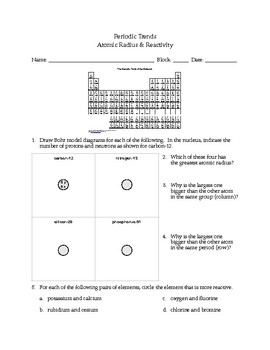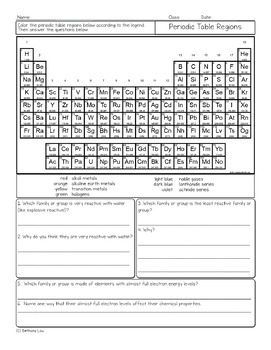

Explain how ionic charge is related to the number of valence level electrons. If electrons are gained, there is a negative ionic charge.Ĥ. If electrons are lost, there is a positive ionic charge. The general pattern for ionic charge going horizontally across a period is 1+, 2+, 3+, 4+, 4-, 3-, 2-, 1-, 0.
Trends in the periodic table chemistry worksheet full#
Since He, Ne, and Ar all have full valence levels and do not gain nor lose electrons, they have an ionic charge of 0. It will neither gain nor lose electrons because its valence level is also full. He has a full valence level with just 2 electrons, since all of its electrons are in level 1. Ne and Ar have a full valence level with 8 electrons, so they will neither gain nor lose electrons. He, Ne, and Ar are all found in column 18. They lose a single valence electron, giving a 1- charge, and are in column 17. O and S gain 2 electrons, resulting in a 2- charge, and are found in column 16. They are in column 15 on the periodic table. Nitrogen can lose all 5 electrons, resulting in a 5+ charge.

N and P have 5 valence level electrons, so they will likely gain 3 electrons, resulting in a 3- charge. They are in column 14 of the periodic table. They have an ionic charge of 4- or 4+ respectively. C and Si have 4 valence level electrons, which means they can gain 4 electrons or lose 4 electrons. They are in column 2 of the periodic table.ī and Al have 3 valence level electrons, an ionic charge of 3+, and lose 3 valence level electrons. Excepting helium, elements with 2 valence level electrons (Be and Mg) have an ionic charge of 2+ and lose 2 electrons. They are in column 1 of the periodic table. Level 3, elements 11 to 18, follow the same pattern as level 2-1 to 8 valence level electrons.ģ.ĝescribe and explain the pattern in ionic charge for the first 18 elements.Įlements with 1 valence level electron (H, Li, Na) have an ionic charge of 1+ and lose 1 electron. Level 2, elements 3 to 10, have 1 to 8 valence level electrons respectively. The first row, H and He, has 1 and 2 valence level electrons. Describe and explain the pattern in the number of valence level electrons for the first 18 elements. Eight electrons need to be added to the third level to complete it.Ģ.

Elements 11 to 18 follow the same pattern as elements 3 to 10, except electrons are placed in the third level instead of the second level. Elements 3 to 10 fill 1s, 2s, and 2p, totaling 8 electrons for the level. Describe and explain the pattern in electron configurations for the first 18 elements.


 0 kommentar(er)
0 kommentar(er)
